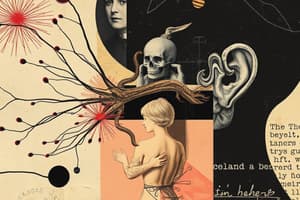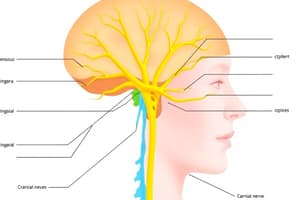Podcast
Questions and Answers
Which type of receptor is primarily responsible for detecting changes in blood glucose levels?
Which type of receptor is primarily responsible for detecting changes in blood glucose levels?
- Interoceptors (correct)
- Proprioceptors
- Nociceptors
- Exteroceptors
The sensation of balance relies primarily on the function of:
The sensation of balance relies primarily on the function of:
- Nociceptors
- Thermoreceptors
- Mechanoreceptors (correct)
- Exteroceptors
Which of the following best describes the function of exteroceptors?
Which of the following best describes the function of exteroceptors?
- Monitoring the internal state of an organ.
- Detecting the stretch of muscles and tendons.
- Responding to stimuli from the external environment. (correct)
- Registering tissue damage.
A person touches a hot stove and immediately feels pain. Which type of receptor is primarily responsible for this sensation?
A person touches a hot stove and immediately feels pain. Which type of receptor is primarily responsible for this sensation?
What is the primary role of proprioceptors in the body?
What is the primary role of proprioceptors in the body?
Which of the following scenarios primarily involves mechanoreceptors?
Which of the following scenarios primarily involves mechanoreceptors?
If a person is unable to consciously recognize their blood CO2 level, which type of receptor is most likely involved in its detection?
If a person is unable to consciously recognize their blood CO2 level, which type of receptor is most likely involved in its detection?
What distinguishes nociceptors from thermoreceptors, given their similar activation by extreme heat or cold?
What distinguishes nociceptors from thermoreceptors, given their similar activation by extreme heat or cold?
Which of the following is NOT a type of receptor that responds to stimuli in the skin?
Which of the following is NOT a type of receptor that responds to stimuli in the skin?
What type of receptor is responsible for detecting rapid, repetitive deflections of the skin?
What type of receptor is responsible for detecting rapid, repetitive deflections of the skin?
Where are Merkel disks located?
Where are Merkel disks located?
What is the term for the crossing of sensory information to the opposite side of the central nervous system?
What is the term for the crossing of sensory information to the opposite side of the central nervous system?
Which of these is NOT a chemical factor released from damaged cells that stimulates nociceptors?
Which of these is NOT a chemical factor released from damaged cells that stimulates nociceptors?
What is the name of the location where visual information crosses the midline?
What is the name of the location where visual information crosses the midline?
What type of receptors are responsible for sensing different tastes?
What type of receptors are responsible for sensing different tastes?
What is transduced into electrical and/or chemical energy by our sensory systems?
What is transduced into electrical and/or chemical energy by our sensory systems?
In the auditory system, the 'map' is based on tones. What is this orderly map called?
In the auditory system, the 'map' is based on tones. What is this orderly map called?
Where is the primary auditory cortex (A1) located?
Where is the primary auditory cortex (A1) located?
Which of the following receptors is NOT located in the dermis?
Which of the following receptors is NOT located in the dermis?
What type of receptors are primarily involved in detecting pain?
What type of receptors are primarily involved in detecting pain?
Which of the following is TRUE about free nerve endings?
Which of the following is TRUE about free nerve endings?
What structure in the medulla is responsible for calculating the location of sounds?
What structure in the medulla is responsible for calculating the location of sounds?
Where does some touch information cross the midline?
Where does some touch information cross the midline?
What does static equilibrium primarily encode?
What does static equilibrium primarily encode?
Where are the maculae located in relation to the semicircular canals?
Where are the maculae located in relation to the semicircular canals?
What is the role of otoliths in the maculae?
What is the role of otoliths in the maculae?
What happens in the semicircular canals during head rotation?
What happens in the semicircular canals during head rotation?
What results when there is a conflict between the visual system and the vestibular system?
What results when there is a conflict between the visual system and the vestibular system?
Which of the following movements is primarily detected by the semicircular canals?
Which of the following movements is primarily detected by the semicircular canals?
Which cranial nerve carries the axons from the primary afferent fibers involved in vestibular sensation?
Which cranial nerve carries the axons from the primary afferent fibers involved in vestibular sensation?
What feature stabilizes the position of otoliths during head tilting?
What feature stabilizes the position of otoliths during head tilting?
How are head movements represented in the vestibular system?
How are head movements represented in the vestibular system?
What phenomenon can occur if one experiences zero-gravity conditions?
What phenomenon can occur if one experiences zero-gravity conditions?
Flashcards
Exteroceptors
Exteroceptors
Receptors that receive stimuli from outside the body, such as light, sound, touch, taste, and smell.
Interoceptors
Interoceptors
Receptors that sense stimuli from inside the body, like changes in blood oxygen, glucose, or CO2 levels.
Proprioceptors
Proprioceptors
Receptors that provide information about the position of body parts and movement, combining information about muscle and tendon stretch with gravity.
External Sensory Perception
External Sensory Perception
Signup and view all the flashcards
Mechanoreceptors
Mechanoreceptors
Signup and view all the flashcards
Thermoreceptors
Thermoreceptors
Signup and view all the flashcards
Nociceptors
Nociceptors
Signup and view all the flashcards
Sensory Perception
Sensory Perception
Signup and view all the flashcards
Sensory Transduction
Sensory Transduction
Signup and view all the flashcards
Sensory Receptors
Sensory Receptors
Signup and view all the flashcards
Photoreceptors
Photoreceptors
Signup and view all the flashcards
Osmoreceptors
Osmoreceptors
Signup and view all the flashcards
Decussation
Decussation
Signup and view all the flashcards
Somatosensory Information
Somatosensory Information
Signup and view all the flashcards
Merkel Disks
Merkel Disks
Signup and view all the flashcards
Meissner Corpuscles
Meissner Corpuscles
Signup and view all the flashcards
Ruffini Endings
Ruffini Endings
Signup and view all the flashcards
Pacinian Corpuscles
Pacinian Corpuscles
Signup and view all the flashcards
Free Nerve Endings
Free Nerve Endings
Signup and view all the flashcards
Static Equilibrium
Static Equilibrium
Signup and view all the flashcards
Auditory Cortex
Auditory Cortex
Signup and view all the flashcards
Dynamic Equilibrium
Dynamic Equilibrium
Signup and view all the flashcards
Maculae
Maculae
Signup and view all the flashcards
Otoliths
Otoliths
Signup and view all the flashcards
Otolith Membrane
Otolith Membrane
Signup and view all the flashcards
Dynamic Equilibrium
Dynamic Equilibrium
Signup and view all the flashcards
Semicircular Canals
Semicircular Canals
Signup and view all the flashcards
Ampullae
Ampullae
Signup and view all the flashcards
Endolymph
Endolymph
Signup and view all the flashcards
Vestibulo-ocular Reflex (VOR)
Vestibulo-ocular Reflex (VOR)
Signup and view all the flashcards
Study Notes
Receptor Classification by Input Source
- Exteroceptors: Receive stimuli from the external environment, including light, sound, and touch. Associated with the five senses.
- Interoceptors: Receive stimuli from the internal environment, such as blood oxygen levels, glucose levels, CO2 levels, and stomach/intestinal stretch. Generally, these do not reach conscious perception.
- Proprioceptors: Integrate information about body part position, muscle/tendon stretch, and gravity to determine joint position in space.
Types of Receptors
- Mechanoreceptors: Detect movement, including pressure, touch, muscle stretch, and sound. Also involved in balance.
- Thermoreceptors: Detect temperatures between 4°C (40°F) and 50°C (122°F). Below or above these ranges, tissue damage and pain signals are perceived.
- Nociceptors: Detect harmful or damaging stimuli. Activated during tissue damage from various chemicals released from damaged cells (e.g., K+, H+, ATP, NO, histamine, prostaglandins, bradykinin, serotonin).
- Photoreceptors: Detect light (photons). Different wavelengths correspond to different colors; each primary color (red, yellow, blue) corresponds to a separate type of photoreceptor.
- Chemoreceptors: Detect chemicals from both the internal and external environments, such as taste (sugars, acids, salt), smell (airborne molecules), and blood oxygen/carbon dioxide/pH levels.
- Osmoreceptors: Detect solute levels in the blood, regulating water retention/loss through chemical signaling.
Somatosensory (Touch) Receptors
- Merkel disks: Located in the epidermis, detect light touch and tiny skin surface deflections.
- Meissner corpuscles: Located in the dermis, detect light touch.
- Ruffini endings: Located deep in the dermis, detect larger skin deflections (crude touch).
- Pacinian corpuscles: Located deep in the dermis, detect rapid and repetitive skin deflections (vibration).
- Free nerve endings: Located throughout the dermis, and can detect pain (nociceptors), temperature (cold or heat), and itch.
Auditory System
- Auditory transduction: Sound waves enter the ear, triggering mechanical movement in hair cells in the cochlea, which transduce this movement into electrical signals.
- Sound localization: The superior olivary nucleus in the medulla calculates differences in sound arrival time between the two ears to determine the source of a sound.
- Auditory cortex (A1): Located in the temporal lobe, A1 or Brodmann's areas 41 and 42, maps sounds based on their frequency and not location (tonotopic map).
Vestibular System
- Static equilibrium: Determines the head's tilt/position in relation to gravity using maculae in the utricle and saccule of the inner ear. Otoliths embedded in the otolith membrane detect tilt.
- Dynamic equilibrium: Detects head rotation/movement using semicircular canals and ampullae, which contain hair cells sensitive to fluid movement.
- Encoding mechanism: Movement of otoliths in the otolith membrane or fluid in the canals bend hair cells, triggering signals to the brain about the direction and speed of movement.
Central Pathways for Sensory Information
- Processing: Sensory signals are transduced into electrical and/or chemical signals processed through nuclei in the central nervous system and, if conscious perception is intended, through the thalamus to the cortex.
- Decussation: Most sensory information crosses to the opposite side of the brain (decussation) at some point in its central pathway, e.g., the optic chiasm (vision) or sensory decussation (touch information) in the medulla.
Studying That Suits You
Use AI to generate personalized quizzes and flashcards to suit your learning preferences.




